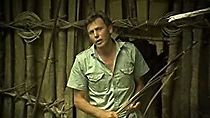|
At the time this documentary was produced, New Guinea peoples in the highlands in the center of that country had never had contact with Europeans, nor had this part of the interior been mapped from the ground (thus “blank on the map”). Since aerial maps did exist, Bragge (a government official) and his staff were able to plan their journey, mainly by river and tributary, and then aiming toward areas where trees had been cleared, in the belief that these might represent “gardens,” small plots of land on which natives grew food. These maps also allowed planning for an air drop two weeks into the journey. Attenborough, Bragge, and national police assigned to Bragge set off in a party of 101, mostly bearers bringing food, canvas for shelters, and of course the cameras and film, medicines and other supplies needed for the expedition. Some of the staff had to go ahead and break trail for the rest, since after the last leg of the journey that could be made by canoe had been completed, there was no trail from that last Europeanized settlement. It was necessary to go up one mountain and down to the next and over to another river to meet the airdrop. In all this time, the expedition met no natives, although they did encounter a deserted ceremonial house with a warm fireplace. By a mischance, they had not been able to procure an interpreter likely to know the language of the people they sought. All they knew was the name that people called themselves—and of course they weren’t sure exactly whom they might encounter. Headhunters had once been known in these areas. Only a few days before their scheduled return, with no sighting of natives, and desperate to achieve their goal of contact, Bragge sent a bearer to stand out in a relatively clear area and repeatedly call the name of the people they had heard lived there. The next morning, a small group of men appeared and efforts began to understand one another. After some preliminary gifts, Bragge suggested trading for native taro and bananas, and the men returned to their unseen village. They came back the following day with trade goods, and the expedition found that items such as glass beads and newspaper, valued by other New Guinea tribes, were not valued by this group, who did accept salt. Finally Bragge suggested that the men show them their homes, at which point suspicion set in. The film appears to show that only three men followed the small group—Bragge, Attenborough, and the cameraman, apparently unarmed, but as the Europeans lagged behind the natives, the latter disappeared noiselessly into the jungle and did not return when the name of their people was called again. Throughout the expedition, Attenborough and the cameraman recorded birds (including a few of one type of bird of paradise), an echidna, leeches, a “tree kangaroo” and other wildlife, as well as plants, the daily life of the expedition, and the weather. |
||
| Ratings: | IMDB: 8.3/10 | |
| Released: | December 29, 1971 | |
| Runtime: | 59 min | |
| Genres: | Documentary | |
| Companies: | Australian Broadcasting Corporation BBC | |
| Cast: | David Attenborough Laurie Bragge | |
| Crew: | David Attenborough | |



dampyiel2200 : Contains spoilers. Click to show. I really wanted Caroline to win. Danielle I don't think is doing a very good job and is ju...